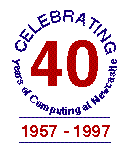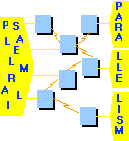
Parallelism Research Group
Pete Lee


|
Parallelism Research GroupPete Lee |

|
The Parallelism Research Group began to take shape in 1986 when Pete Lee returned to take one of the three newly created chairs in the Department after spending a number of years working in the computer industry in the USA. (The other new professors were Tom Anderson and Santosh Shrivastava.)
Despite having a research background in dependability from his earlier years at Newcastle (1975-1981), Pete felt that the Department already had sufficient research efforts in those areas. His experience in working for a startup company making shared memory multiprocessors had led to his interest in that computer architecture and parallel processing, and hence to the formation of the parallelism research activity within the Department. This new research focus fitted well with work of some of the existing members of the Department, particularly for staff who were interested in numerical methods and the production of parallel programs in these areas. These staff included Dr John Lloyd, Dr Chris Phillips and Dr Ken Wright.
The initial focus of the Parallelism Research Group was on the exploitation of shared memory multiprocessor (SMP) architectures. This architecture was just becoming commercially significant, with the low cost of VLSI CPU chips being exploited to provide inexpensive, general-purpose Unix computing engines with modest levels of parallelism - typically up to about 20 CPUs. The Newcastle group obtained an 8-processor Encore Multimax 120 SMP system, subsequently upgraded to an 8-processor Multimax 320. At this time in the UK, though, the transputer bandwaggon was rolling, and was attracting the major proportion of research funding targetted at parallel computing. It was very difficult to obtain funding for work with other architectures such as shared memory multiprocessors which, despite offering a constrained number of parallel CPUs, held some attractions such as an easier programming model and support for efficient communications through shared memory.
Initial research work concentrating on
This topic of programming tools for parallel computing has remained an active research interest at Newcastle ever since. Other research activity in the parallel computing research group has focussed on numerical algorithms ***refs*** and on parallel simulation ***ref***. Professor Isi Mitrani's work on this latter topic with colleagues at Bell Laboratories led to a patent on "Unbounded Parallel Simulation" - a topic which he is still actively investigating, now with support from the MoD.
In its early expertise in SMPs, in 1988 a large grant from the Department of Trade and Industry was obtained. This grant was part of a £0.5M project to establish The Centre For Multiprocessors and enabled the purchase of a second, larger Multimax system. The main aim of this project, led by Pete Lee, was to provide a centre of excellence in the SMPs for British Industry, to encourage industrial exploitation in the UK of this form of parallel processing. Michael Stoker, who was a PhD student, transferred to the RA post associated with the Centre.
In addition, two collaborative projects led to the funding of significant enhancements to the second Multimax system:
Shortly afterwards the parallelism group was involved in a successful bid for an ESPRIT-funded project named FASST. This project, funded from 1991 to 1994, was to investigate fault-tolerant shared memory multiprocessor architectures.
Work in the Parallelism Group expanded to other parallel architectures, in addition to shared-memory multiprocessor systems. Chris Phillips had a sabbatical year in 1989 in which he acquired significant experience in parallel processing for numerical applications on transputer-based distributed memory architectures at Liverpool University. (T.L. Freeman and C. Phillips, Parallel Numerical Algorithms, Prentice-Hall 1992.) Graham Megson, Chris Phillips and Pete Lee were awarded a Newcastle University Research Grant in 1990 that permitted the purchase of a 16 T8-processor transputer array. Special purpose parallel architectures such as systolic architectures and neural networks were the specific research topic of Graham Megson, before his move to a chair at Reading in 1995. *** refs***. In each area there was work on tools, libraries and techniques to assist users to apply parallel hardware effectively.
In August 1995 the Parallelism Group was significantly strengthened by the arrival of Dr. Paul Watson. Paul had been working at ICL where he was one of the designers of Goldrush MegaServer parallel database machine. Previous to this, while a lecturer at Manchester University, he had worked closely with ICL on the design of two prototype parallel machines. As well as parallel database systems, Dr. Watson's research interests are in the design of implicit parallel systems in which it is the system, not the programmer, that is responsible for creating and managing parallelism.
Paul Watson was successful in a bid to the 1996 HEFCE Joint Research Equipment Initiative for funds to purchase a Goldrush system. The main objective behind the award of the funding is to facilitate and promote UK research into non-numeric parallel computing. This is recognised as a key emerging area by the computing industry, however, the existing UK research community is being held back by the difficulties of gaining access to a commercial strength non-numeric parallel system on which to work, and potential users in many other disciplines are largely unaware of the possibilities that are being opened up by the data storage and processing capabilities of these types of systems. The Goldrush at Newcastle will fill this void, allowing UK researchers, in a wide variety of disciplines, both at Newcastle and elsewhere, to carry out world-class research into this important area.
The Goldrush system is intended to provide a resource for researchers in other Departments at Newcastle, and also at other Universities. This is reflected by the list of co-investigators:
The Goldrush will be the major resource of the recently established Centre for High Performance Computing and Networking at Newcastle University. The Centre aims to provides research facilities, and an active community who can share their knowledge and experiences.
The continuing fall in price and increase in speed of PC systems together with the advent of high-speed LANs such as Fast Ethernet and ATM has led the Parallelism Research Group's efforts away from SMP towards distributed, parallel systems composed of commodity hardware. A system of 13 PCs (133 MHz) interconnected by ATM and Fast Ethernet has been purchased to support research into so-called Affordable Parallel Platforms. Research interests are still addressing tools to help exploit the potential parallelism that such systems offer.

Multimax 120
The first SMP obtained for the parallelism work at Newcastle was an Encore Multimax 120. This system was purchased in July 1987 with money provided partly by Pete Lee's "new Professor's" equipment grant from the University and with Departmental funds. This system (named "Turing") comprised 8 National Semiconductor 32032 CPUs running at 10 MHz (0.75 MIPS), with 16MB of main memory. This was a powerful system in those days, and provided a Unix service to the Department as well as supporting the parallelism work.
In 1988 Turing was upgraded to a Multimax 320, containing the next generation of CPU cards, that is to 8 National Semiconductor 32332 CPUs (15MHz, 2 MIPS), and provided faithful service including a long period without maintenance support, until it was decommissioned in 1996.
In 1988 a second Multimax (named "Newton") was acquired for the Centre for Multiprocessing. With additional upgrades from other projects, this machine, the first Multimax 520 in the country, comprised 14 National Semiconductor 32532 (30 MHz, 8.5 MIPS) and 128MB of main memory. Like Turing, Newton provided long and reliable service both to researchers as well as to Unix users in the Department. It is still running in 1997.
In 1996 the Department provided funding to support the putchase of 13 133MHz-based PC systems, running Linux and interconnected by ATM and Fast Ethernet. This collection of machines is termed the Newcastle APP (Affordable Parallel Platform).
In 1997, Paul Watson obtained an £1.3M ICL Goldrush Megaserver. The Newcastle Goldrush consists of
In 1996 the Department provided funding to support the putchase of 13 133MHz-based PC systems, running Linux and interconnected by ATM and Fast Ethernet. This collection of machines is termed the Newcastle APP (Affordable Parallel Platform).